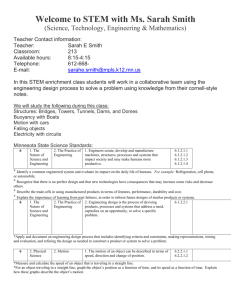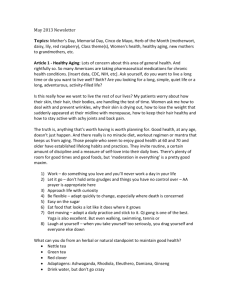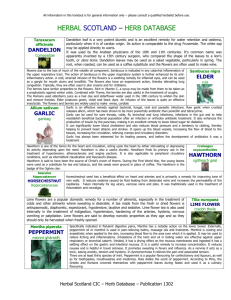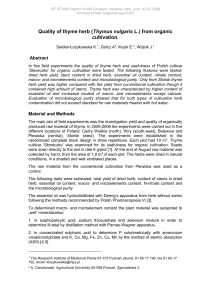Lecture 10
advertisement
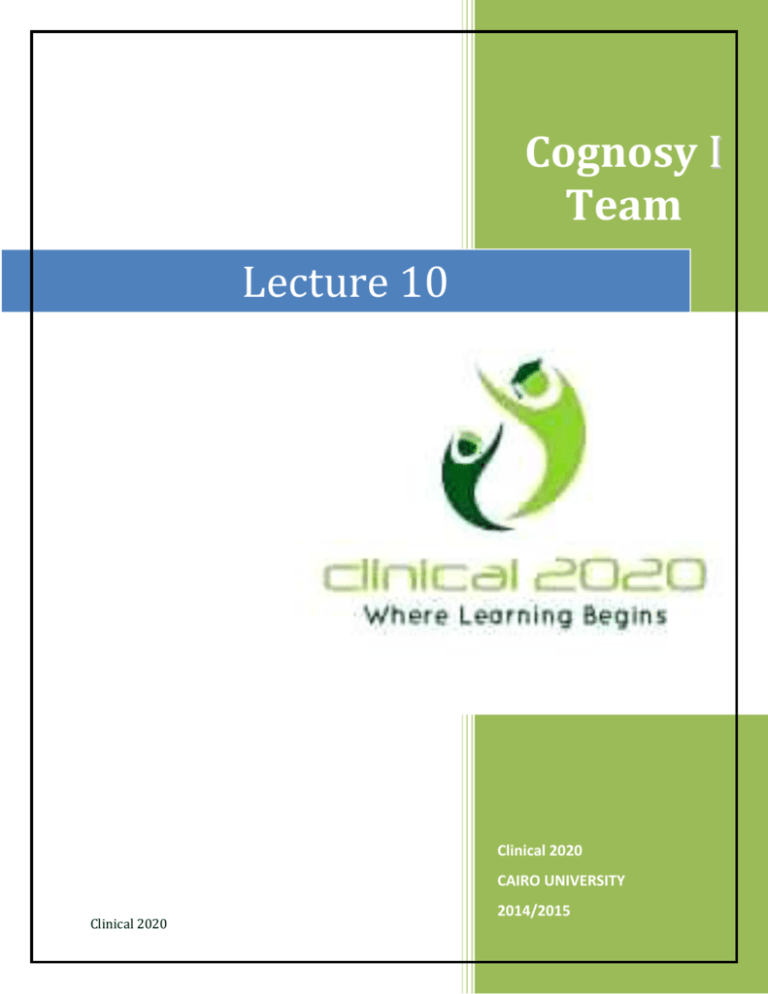
Cognosy I Team Lecture 10 Clinical 2020 CAIRO UNIVERSITY Clinical 2020 2014/2015 Page 1 Herb The word herb (sometimes referred to as botanical) has several different meanings depending on the perspective: commercial terms horticultural terms taxonomic terms terms of herbal medicine herb generally refers to plants used for culinary purposes. Additionally the terminology differentiates Temperate Zone plants from tropical and sub-tropical plants (i.e., spices). herb refers to "herbaceous," which describes the appearance of the plant (i.e., a non-woody, vascular plant). herb generally refers to the aboveground parts or the aerial parts (i.e., the flower, leaf, and stem). herb refers to plants used in various forms or preparations, valued for their therapeutic benefits, and sold as dietary supplements Botanists describe an herb as a small, seed bearing plant with fleshy, rather than woody, parts (from which we get the term "herbaceous"). In addition to herbaceous perennials, herbs include trees, shrubs, annuals, vines, and more primitive plants, such as ferns, mosses, algae, lichens, and fungi. Type of herb Herb as a whole plant ( include the root ) e.g. Vinca Herb as aerial part only e.g. Lobelia Tops of aerial parts Cannabis Non Differentiated plant Body or thallus The Stem in botany it is the plant axis that bears buds and shoots with leaves and at its basal end there is the roots. The stem is the stalk of a plant or the main trunk of a tree. The stem conducts water, minerals, and food to other parts of the plant it may also store food, and green stems themselves produce food. In most plants the stem is the major vertical shoot, in some it is inconspicuous, and in others it is modified and resembles other plant parts (e.g., underground stems may look like roots). Holds up the plant Above the Ground Consists of 2 parts Main stem Branches Has 2 types Hard Stem Soft stem Clinical 2020 Page 2 Forms of stem Underground Aerial Erect or strong Stem Trailler prostrate or Documbent procumbent Clinical 2020 Weak Stem Creepers Climbers 1. Rootllet Climbers 2. Hook Climber 3. Tendril Climbers 4. Leaf Climbers 5. Stem Climbers or Twiners 6.Lianas Page 3 Branching of the stem Lateral Dichotomous Racemose or Indefinite Cymose or Definite Uniparous Cyme Biparous Cyme Mentha Multiparous Cyme Thyme Syn Origin peppermint The dried leaves and flowering tops of Mentha piperita Linne Family Labiatae. not less than 0.5% Volatile oil Summer Thyme, Garden Thyme the dried aerial parts of Thymus vulgaris L. Family Labiatae. not less than 1.2% Volatile oil G.O Europe and North America Mediterranean region, Constituents Contra indications Action Mainly volatile oil (0.7 to 1.5% contains up to Volatile Oil ( up to 1%) Containing Phenolic compound, Mainly Thymol and Carvacrol 78% menthol ) (up to 64% of the oil ) Tannin and Flavonoids Flavonoids, Apigenin, Luteolin Saponin Gallstones and severs liver damage Gastro-esophageal reflux disease. Avoid use with infants and small children Internally Antispasmodic Carminative Choleretic Diaphoretic Anti-emetic Cardiac insufficiency During Pregnant Powerful Antiseptic for respiratory Tract Antimicrobial ( antifungal, antibacterial ) Carminative, digestive and antispasmodic Diuretic and urinary antiseptic Externally Rubificant Local anesthetic Antiseptic Antipyretic Clinical 2020 Page 4 Uses In aromatherapy menthol oil is indicated to treat: Used for mouth infections Inhalation of the herb and the oil in boiling water are effective against upper respiratory infection Rheumatic and joints pain Used to relieve itching and inflammation of skin The oil is helpful remedy in fevers and influenza since it promotes sweating Internally Treatment of dry cough, whooping cough bronchitis, asthma, and catarrhs of the upper respiratory tract Used to improve digestion, flatulence, Colic and internal parasites In urinary tract disorders Topical applications of thyme extract Used in the treatment of minor wounds Used as an antibacterial agent in oral hygiene Side Effect ---------------- - Mintovex : Massage gel - Mentholax - Otrivine Thyme Oil when used internally in a large dose causes nausea and respiratory arrest for this reason the herb preferred to the oil Nausea and respiratory arrest have been reported when thyme oil is used internally in large dose Thymol is especially toxic and can produce abdominal pain, headache, convulsions and respiratory collapse - Bronchicum : for improve function of bronchi and antispasmodic cough. Thyme fluid extract ---------- 5 g Primula root fluid extract ----2.5 g -Bronchipret: for bronchitis. Loosens thick mucus Heals bronchial inflammation Reduces coughing fits -Fluid extract ,Tincture (1: 10, 70% ethanol): 40 drops up to 3 times daily. -Topical use: 5% infusion as a gargle or mouthwash . Chemical test Thymol crystals + 1ml of glacial acetic acid + few drops of conc.H2SO4 + 1 drop of HNO3 Bluish green Color Clinical 2020 menthol crystals + few drops of conc.H2SO4 + few drops of Vanillin / H2SO4 Orange Yellow Color Page 5




